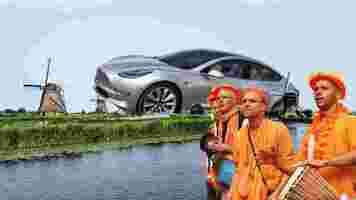Tesla reportedly gets India to consider slashing taxes on EV imports
The Indian government is considering tax cut from 60% to 40% for imported EVs.

According to a report from Reuters , the authorities are considering these revised tax rates for EVs valued at less than $40,000 — inclusive of cost, insurance, and freight. The report noted that for EVs costing more than $40,000, the revised tax rate would be 60% — down from 100%.
In July, Elon Musk said he wants to bring Tesla to India, but import taxes are too high. And currently, the company doesn’t have any facility in the country to produce its vehicles. The company also made an official pitch to the government later in the month to reduce taxes and present a proposal to set up manufacturing in India.
The Reuters report noted that while overseas carmakers like Mercedez have appealed to reduce tax rates in the past, the Indian government is considering it for the first time after Tesla’s appeal.
While Tesla and other foreign carmakers like Hyundai are supporting tax cuts , Indian manufacturers like Ola and Tata want local companies to benefit from these cuts as well.
Car sales in India hover around 3 million per year, but EVs aren’t popular enough to make a dent in overall market share. That’s not surprising, given that they’re generally significantly more expensive than the raft of ICE models available, and the country doesn’t yet have much of a public charging point infrastructure to speak of.
India has ambitious goals for EV adoption: it wants 80% of two-wheelers and 30% of four-wheelers to be electric by 2030. But there’s a long way to go for that.
The Dutch went wild for EVs in December
According to figures from Schmidt Automotive Research , Western Europe saw a new record number of registrations of battery electric vehicles in December 2020.

Over 100,000 new electrically powered passenger vehicles were registered across the 18-country market-region which includes nations like Norway, the Netherlands, and Germany.
Speaking of which, even though Norway is seen as Europe’s EV utopia, it was bested by the Netherlands, where BEVs made up a greater proportion of all new car registrations.
In the low country, 68.9% of new passenger car registrations were battery powered electric vehicles.
This was 2% higher than in Norway, the world’s first country where more EVs than gasoline cars were sold across the entire year.
Indeed, reports yesterday confirmed that , across all of 2020, 54.3% of all new cars sold in Norway were battery electric vehicles. In 2019, that figure was 43.4%. A decade ago, it was just 1%.
Whilst the Dutch might have the Norwegians beat in December, it will need to continue this trend if it’s to catch up over the course of an entire year.
To put these figures into context, according to numbers from EV Volumes , the global share of BEV and PHEV vehicles for the first half of 2020 was just 3%.
Projections published by Automotive News early last year suggest that global sales of EVs will outstrip combustion engine sales by 2030.
This isn’t surprising when we consider the fact that governments around the world are taking steps to dissuade citizens from buying fossil fuel cars with subsidies and bans.
In 2025, Norway will ban the sale of new combustion vehicles, and the Netherlands is set to follow in 2030 with similar recommendations.
SHIFT is brought to you by Polestar. It’s time to accelerate the shift to sustainable mobility. That is why Polestar combines electric driving with cutting-edge design and thrilling performance. Find out how .
Voi research claims escooters can boost public transport use
This article was originally published by Christopher Carey on Cities Today , the leading news platform on urban mobility and innovation, reaching an international audience of city leaders. For the latest updates, follow Cities Today on Twitter , Facebook , LinkedIn , Instagram , and YouTube , or sign up for Cities Today News.

A survey from Swedish micromobility firm Voi has found that incorporating e-scooters into the public transport ecosystem can help boost ticket sales at key city locations.
The study, carried out in the German city of Stuttgart, found there was a 35 percent increase in rail tickets purchased by Voi users who ended their journeys at Bad Cannstatt station – one of the largest train stations in the city – when compared to other locations.
The findings were discussed during Voi’s ’15-Minute City’ symposium, an online event which featured speakers from the transport industry, including Carlos Moreno – the Franco-Columbian academic central to the creation of the 15-minute city concept.
“For too long we have accepted that cities will be noisy, polluted and draining places but there is no need to continue with the status quo,” said Moreno, Scientific Director of the ETI chair at the Sorbonne Panthéon University.
“The time is now to rethink and design our cities to put people first and the answer is the 15-Minute City – by prioritising walking, scooting and cycling, we can transform cities into liveable places.
“If we want to make urban life more healthy and flexible, we need to ensure that all citizens are empowered and informed in this transformation and discussions like this are needed to achieve real change.”
Last mile
Voi teamed up with rail operator S-Bahn Stuttgart for the study, and the firm’s e-scooters were integrated with the city’s multimodal Mobility Stuttgart app.
Fredrik Hjelm, co-founder and CEO of Voi Technology, said: “The reality is that cars still carry a large part of the daily traffic in our cities but we need to reduce our reliance on them and create cities where we can enjoy our lives, reach all important services and breathe more easily.
“We think micromobility is the key to unlocking the vision of 15-minute cities and we want to do everything we can to make that transition happen.”
The survey also found that the number of ‘last-mile’ Voi e-scooter trips increased by more than 250 percent at the Bad Cannstatt station after parking racks were installed.
Replacing cars
Voi says its research indicates that e-scooters can reduce car use, a claim touted by a number of e-scooter firms.
But the lack of independent data on a correlation between an increase in e-scooter use and a decrease in car use means cities are reliant on a limited number of industry-sponsored studies.
German e-scooter firm TIER recently said London’s e-scooter rental scheme could replace five million car trips in the UK capital every year – if it reaches full capacity.
By assessing usage data from operations across 115 cities in the UK and wider Europe, the company estimated a utilisation rate of four rides per day per scooter in London, meaning there will be nearly 80,000 rides per day on e-scooters and over 29 million a year.
According to data from TIER’s own research, 17.3 percent of trips taken on rental e-scooters replace car journeys.
When applying this to London, the firm calculates that 4.9 million car journeys can be replaced by e-scooters every year.
“The potential environmental benefits of switching from cars to e-scooters for short journeys are absolutely staggering when you think about the size and scale of London and the number of vehicles on the roads,” said TIER Regional Manager Fred Jones.
Do EVs excite your electrons? Do ebikes get your wheels spinning? Do self-driving cars get you all charged up?
Then you need the weekly SHIFT newsletter in your life. Click here to sign up .